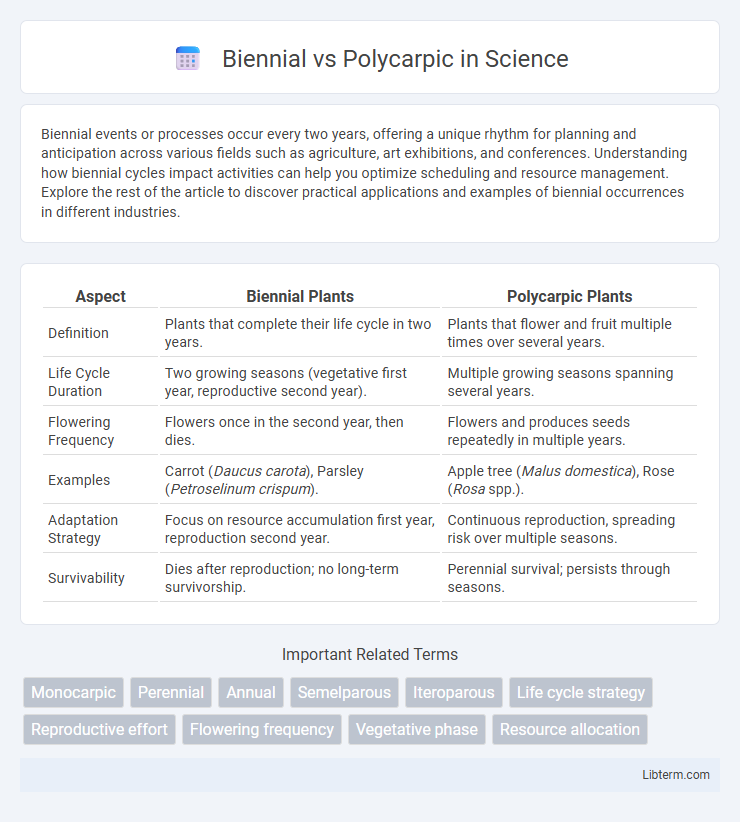Biennial events or processes occur every two years, offering a unique rhythm for planning and anticipation across various fields such as agriculture, art exhibitions, and conferences. Understanding how biennial cycles impact activities can help you optimize scheduling and resource management. Explore the rest of the article to discover practical applications and examples of biennial occurrences in different industries.
Table of Comparison
| Aspect | Biennial Plants | Polycarpic Plants |
|---|---|---|
| Definition | Plants that complete their life cycle in two years. | Plants that flower and fruit multiple times over several years. |
| Life Cycle Duration | Two growing seasons (vegetative first year, reproductive second year). | Multiple growing seasons spanning several years. |
| Flowering Frequency | Flowers once in the second year, then dies. | Flowers and produces seeds repeatedly in multiple years. |
| Examples | Carrot (Daucus carota), Parsley (Petroselinum crispum). | Apple tree (Malus domestica), Rose (Rosa spp.). |
| Adaptation Strategy | Focus on resource accumulation first year, reproduction second year. | Continuous reproduction, spreading risk over multiple seasons. |
| Survivability | Dies after reproduction; no long-term survivorship. | Perennial survival; persists through seasons. |
Understanding Biennial and Polycarpic Plants
Biennial plants complete their life cycle over two years, typically growing foliage and storing energy in the first year before flowering and producing seeds in the second year. Polycarpic plants can flower and set seeds multiple times throughout their lifespan, allowing repeated reproductive cycles. Understanding these growth patterns assists gardeners and agriculturalists in planning planting schedules and crop rotations efficiently.
Botanical Definitions: Biennial vs Polycarpic
Biennial plants complete their life cycle over two growing seasons, typically growing vegetatively in the first year and flowering in the second before dying. Polycarpic plants, on the other hand, have the ability to flower and set seeds multiple times throughout their lifespan without dying afterward. The key botanical distinction lies in biennials being monocarpic with a two-year cycle, while polycarpic species are perennial and capable of repeated reproductive cycles.
Key Life Cycle Differences
Biennial plants complete their life cycle over two years, growing vegetatively in the first year and flowering in the second before dying. Polycarpic plants flower and produce seeds multiple times over several years, maintaining the ability to reproduce repeatedly throughout their lifespan. This key difference influences cultivation strategies, as biennials require a two-year growth period, whereas polycarpics support continuous harvest and propagation.
Growth and Flowering Patterns
Biennial plants exhibit a two-year life cycle, dedicating the first year primarily to vegetative growth and the second year to flowering and seed production before dying. Polycarpic plants, in contrast, undergo multiple flowering and fruiting cycles over several years, allowing continuous growth and reproduction throughout their lifespan. The growth pattern of biennials focuses on resource accumulation initially, while polycarpics allocate energy to both growth and repeated flowering stages, enhancing long-term survival and reproductive success.
Examples of Biennial Plants
Biennial plants complete their life cycle over two years, typically focusing on vegetative growth the first year and flowering in the second. Common examples include carrots (Daucus carota), foxglove (Digitalis purpurea), and parsley (Petroselinum crispum). In contrast, polycarpic plants flower and set seeds multiple times throughout their lifespan.
Examples of Polycarpic Plants
Polycarpic plants such as apple trees (Malus domestica), rose bushes (Rosa spp.), and fig trees (Ficus carica) produce flowers and fruits multiple times throughout their lifespan, ensuring repeated reproductive cycles. Unlike biennial plants like carrots (Daucus carota) and beets (Beta vulgaris) that flower once in their second year before dying, polycarpic species invest in perennial growth and sustained blossoming. Examples of other polycarpic plants include hibiscus (Hibiscus rosa-sinensis), cotton (Gossypium spp.), and tomato plants (Solanum lycopersicum), all known for their ability to generate flowers repeatedly across seasons.
Environmental Adaptations and Survival
Biennial plants complete their life cycle over two growing seasons, allowing them to survive adverse conditions by allocating energy to root development and resource storage during the first year, which enhances resilience against environmental stress. Polycarpic plants, capable of flowering and fruiting multiple times over many years, adapt to variable climates by continuously producing seeds and maintaining perennial structures that store nutrients, improving their long-term survival and reproductive success. These differing strategies reflect adaptations to ecological niches where biennials optimize survival through temporal resource allocation, while polycarpics maximize longevity and reproductive opportunities in stable or fluctuating environments.
Agricultural and Horticultural Significance
Biennial plants complete their life cycle in two years, producing vegetative growth in the first year and flowering in the second, making them valuable for crop rotation and seasonal planning in agriculture. Polycarpic plants, capable of flowering and fruiting multiple times over several years, offer sustained yields and are crucial for long-term productivity in horticulture and perennial crop systems. Understanding the distinctions between biennial and polycarpic growth forms enhances crop selection strategies, optimizing resource use and maximizing harvest efficiency in both farming and gardening contexts.
Challenges in Cultivation and Maintenance
Biennial plants require a two-year lifecycle, facing challenges such as the need for overwintering conditions and careful soil fertility management to ensure successful flowering in their second year. Polycarpic plants, which flower multiple times over several seasons, demand consistent nutrient supply and pest control throughout their extended lifespan. Cultivators must balance moisture levels and pruning practices to optimize growth and flowering cycles in both plant types.
Choosing the Right Plant: Biennial or Polycarpic
Choosing between biennial and polycarpic plants depends on your gardening goals and space availability. Biennial plants complete their life cycle in two years, often flowering in the second year before dying, making them ideal for temporary garden displays or seasonal harvests. Polycarpic plants flower and set seed multiple times over many years, offering long-term yields and sustainable growth for perennial gardens.
Biennial Infographic

 libterm.com
libterm.com